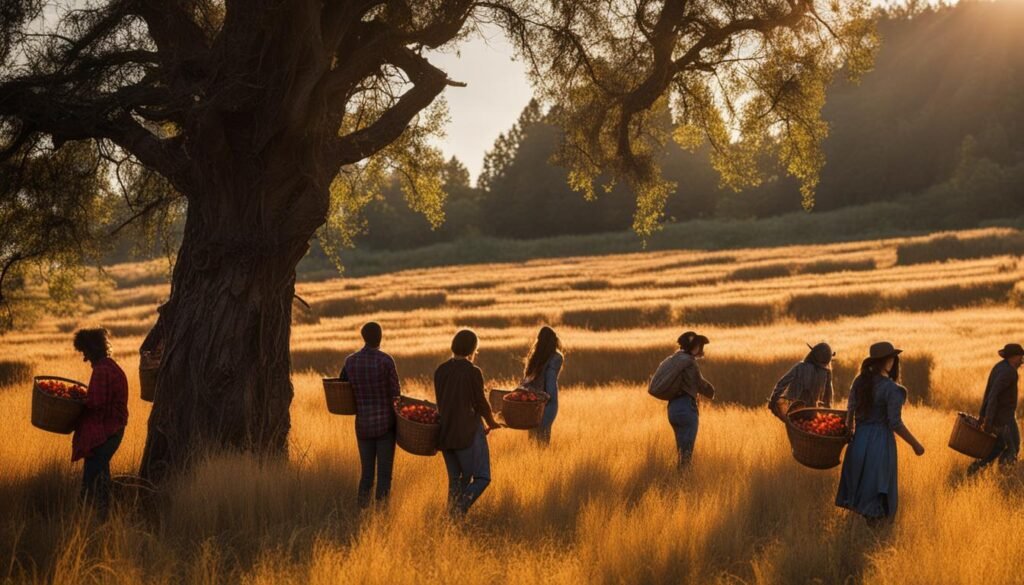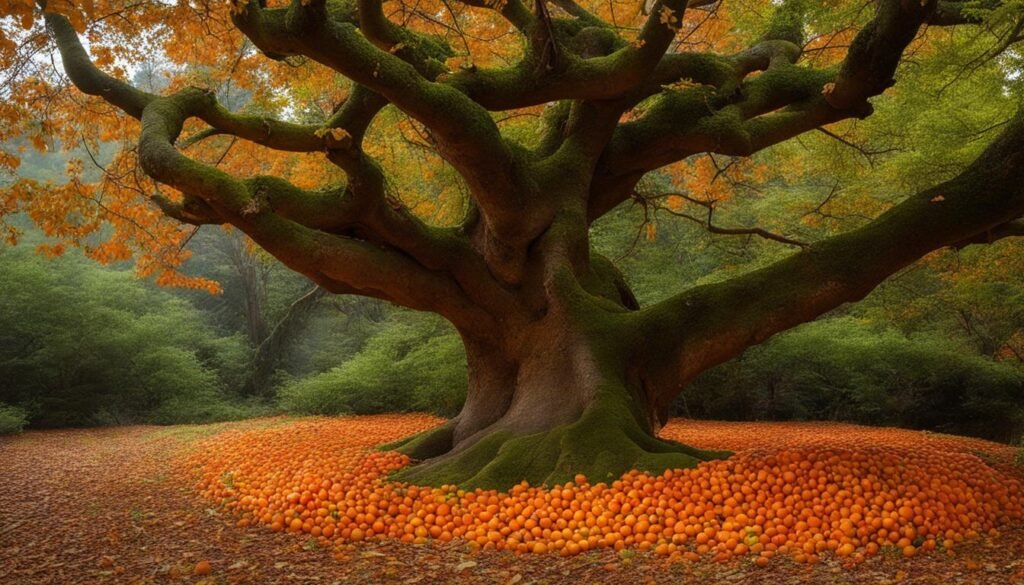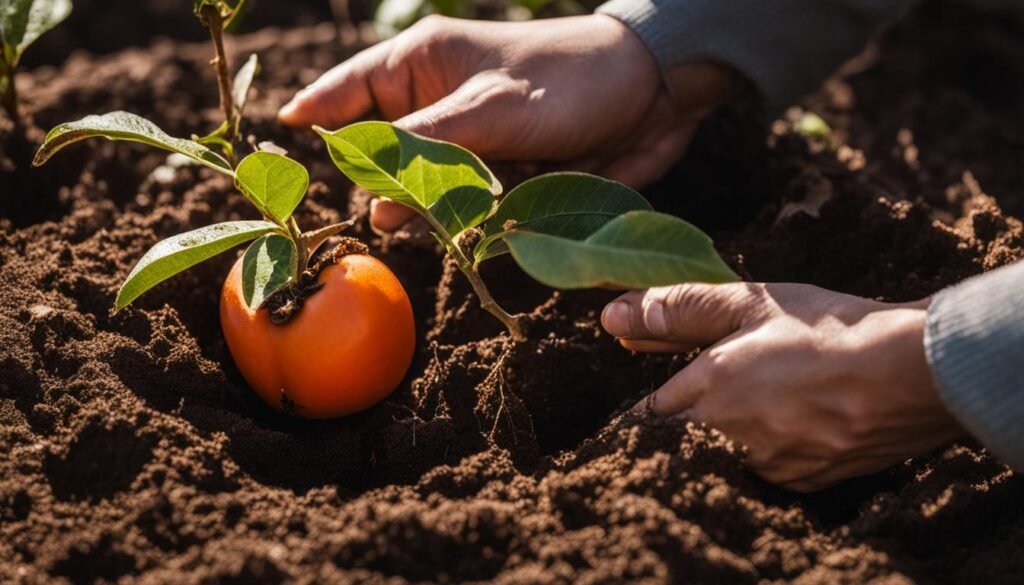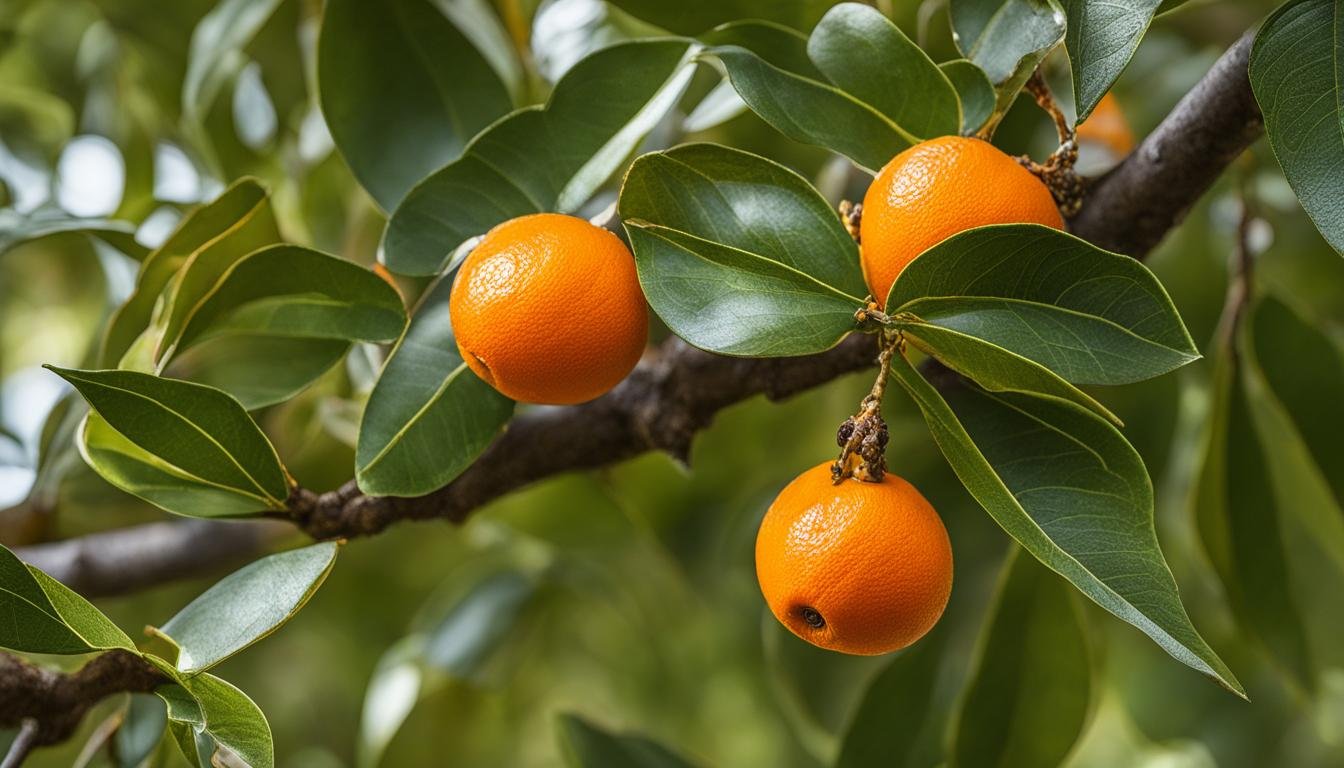Greetings, fellow fruit enthusiasts! Today, I am thrilled to delve into the wonderful world of Diospyros Virginiana, more commonly known as the American persimmon or wild persimmon. This native fruit tree, abundant in the eastern United States, has captured the hearts and taste buds of many with its unique flavor and numerous health benefits.
When it comes to Diospyros Virginiana, there is so much to discover. From its cultivation and uses to its exceptional nutritional value, this fruit tree is truly remarkable. So join me as we explore the wonders of the American persimmon and uncover the secrets of Diospyros Virginiana.
Key Takeaways:
- Diospyros Virginiana, also known as the American persimmon or wild persimmon, is a native fruit tree in the eastern United States.
- It is highly regarded for its unique taste and numerous health benefits.
- We will explore its cultivation, uses, and nutritional value throughout this article.
- American persimmons can be a delightful addition to your garden or natural landscape.
- Stay tuned to uncover the joy and benefits of Diospyros Virginiana!
The Joy of Persimmons
Persimmons are small, orange-brown fruits that bring joy to many during the persimmon season. Their unique taste, described as squishy, sweet, and delicious, is a source of delight for fruit lovers. The joy of biting into a ripe persimmon is unparalleled, making it a highly coveted fruit.
As the persimmon season approaches, anticipation builds for the arrival of these delectable fruits. The vibrant orange color and smooth skin beckon with the promise of a delightful sensory experience. Upon taking a bite, the soft and luscious flesh releases a burst of sweetness that dances on the taste buds. It’s a moment of pure bliss, a moment that captures the essence of the joy of persimmons.
The persimmon is a fruit that brings people together, whether it’s through sharing a freshly picked persimmon with loved ones or incorporating it into various culinary creations. Its versatile nature allows it to shine in both sweet and savory dishes, adding a unique flavor and texture that elevates any recipe. From persimmon tarts and pies to salads and salsas, the possibilities are endless when it comes to exploring the culinary potential of this exquisite fruit.

So, embrace the persimmon season with open arms and savor the joy that this exceptional fruit brings. Let its squishy sweet deliciousness brighten your day and ignite your taste buds, as you indulge in the delightful world of persimmons.
Astringent vs. Non-Astringent Persimmons
When it comes to persimmons, there are two main categories: astringent and non-astringent. Understanding the difference between these two types is key to enjoying the full flavor and texture of this delicious fruit.
Astringent persimmons, like the native American persimmon, may appear soft and mushy when ripe, but they are not ready to eat until they fall off the tree. That’s right – astringent persimmons need to fully ripen off the tree to reach their sweet, honey-like flavor. This ripening process is necessary to remove the tannins that make the fruit astringent.
On the other hand, non-astringent persimmons, such as the popular Asian Fuyu variety, can be eaten when they are still crispy and firm. These persimmons can be picked directly from the tree and enjoyed immediately, without the need for further ripening. The firm texture and mild sweetness of non-astringent persimmons make them a great choice for eating raw or incorporating into salads and other dishes.
Astringent vs. Non-Astringent Persimmons
| Astringent Persimmons | Non-Astringent Persimmons |
|---|---|
| Must ripen off the tree to become sweet | Can be eaten when crispy and firm |
| Soft and mushy texture when fully ripe | Firm texture even when fully ripe |
| Native American persimmon variety | Asian Fuyu variety |
| Higher tannin content | Lower tannin content |
If you have astringent persimmons that are not fully ripe, you can speed up the ripening process by placing them in a paper bag with a ripe banana or apple. The ethylene gas produced by the banana or apple will help soften the fruit and enhance its sweetness. However, it’s important to note that even with this method, the flavor and sweetness may not reach the same level as tree-ripened persimmons.
Whether you prefer the unique flavor of astringent persimmons or the crispness of non-astringent persimmons, both varieties offer a delightful addition to your palate. Experiment with different recipes and enjoy the diverse range of flavors and textures that persimmons have to offer.

Gathering Ripe Fruit
The process of gathering ripe persimmons can be a fun and enjoyable activity for the whole family. Once the persimmons have fallen from the tree, gently pick them up and place them in a basket or container. Be careful not to bruise or damage the fruit, as this can affect their quality.
After harvesting, it’s important to handle the persimmons with care to avoid bruising or damage. Persimmons can be stored at room temperature for a few days if you plan to consume them soon. If you have an abundance of ripe persimmons, you can also freeze the pulp for later use in recipes such as persimmon bread or smoothies.
Table: Tips for Harvesting Persimmons
| Tip | Description |
|---|---|
| Wait for natural fall | Persimmons are ready to be gathered when they fall off the tree on their own. |
| Taste test | Ensure the persimmons are fully ripe by tasting them for sweetness and texture. |
| Handle with care | Avoid bruising or damaging the fruit when picking them up. |
| Store or freeze | Consume ripe persimmons within a few days or freeze the pulp for later use. |
By following these tips and guidelines, you can enjoy the bountiful harvest of ripe persimmons and savor their delicious flavor. Whether eaten fresh or used in various culinary creations, persimmons are a delightful fruit that brings joy to the harvest season.
The Delicate Delights of Persimmon Fruit
Persimmons, with their custardy-soft flesh and thin, breakable skin, offer a delicate and delightful eating experience. The American persimmons are smaller in size, measuring around 1-1.5 inches in diameter, making them the perfect bite-sized treat. However, it’s important to note that persimmons contain several good-sized seeds, which can be easily removed if eating the fruit plain.
When it comes to cooking with persimmons, the pulp can be separated from the seeds using a potato ricer or a food mill. This smooth and velvety persimmon pulp can be used in a variety of recipes, from cakes and pies to jams and sauces. The natural sweetness and unique flavor of persimmons add a delightful twist to any dish.
If you find yourself with an abundance of persimmons at harvest time and don’t have the time to work with them immediately, you can freeze the pulp for later use. Freezing persimmon pulp is a convenient way to enjoy the flavors of persimmons throughout the year. Simply scoop the pulp into a freezer-safe container or bag, seal it tightly, and store it in the freezer until you’re ready to use it.
Overall, persimmons offer a delicate and delightful eating experience. Their small size, ripe flesh, and versatility in cooking make them a truly unique and treasured fruit.
Table: Nutritional Value of Persimmons
| Nutrient | Amount per 100g |
|---|---|
| Calories | 81 |
| Carbohydrates | 21g |
| Fiber | 3.6g |
| Vitamin C | 66% of the Daily Value (DV) |
| Vitamin A | 1% of the DV |
| Potassium | 8% of the DV |
Persimmons and Wildlife
Persimmons are not only a delicious treat for humans but also play a vital role in supporting wildlife. These fruits offer numerous benefits to various species, making them an essential part of our ecosystem.
As dioecious trees, some persimmon trees produce male flowers, while others produce female flowers. Bees, including honey bees, are the primary pollinators of persimmons, ensuring the reproduction of these trees. The resulting fruits, rich in nutrients, are eagerly consumed by a wide range of wildlife.
Deer, raccoons, opossums, foxes, and other small mammals are known to relish the taste of ripe persimmons. These fruits provide an important food source, especially during the fall when other food options may become scarce. Persimmon trees also act as host plants for caterpillars of various moth species, such as luna moths and royal walnut moths, supporting the lifecycle of these fascinating insects.
| Benefit | Wildlife |
|---|---|
| Nutritious fruit consumption | Deer, raccoons, opossums, foxes, and other small mammals |
| Pollinator support | Bees, including honey bees |
| Host plant for caterpillars | Moth species, including luna moths and royal walnut moths |
“Persimmons not only provide a tasty treat for wildlife but also contribute to the overall biodiversity and health of our natural habitats.”
By cultivating persimmon trees in our gardens or preserving them in the wild, we can support and sustain the wildlife populations that rely on these nutritious fruits. The symbiotic relationship between persimmons and wildlife showcases the interconnectedness of nature and reminds us of the importance of conservation efforts.

By familiarizing oneself with the persimmon leaf, flower, fruit, bark, and overall tree features, one can confidently identify the Diospyros Virginiana. This native tree not only adds beauty to the landscape but also provides a bountiful harvest of delicious fruit, making it a valuable addition to any environment.
Persimmons in Folklore and Cultural History
Persimmons have been a part of folklore and cultural history for centuries, with various superstitions and beliefs surrounding these delightful fruits. According to folklore, the shape of the persimmon seeds can be used to predict the severity of winter weather. If the shape of the seed resembles a spoon, it is said to indicate a heavy snowfall. On the other hand, a knife-shaped seed suggests that winter will be bitingly cold.
The rich history of persimmons extends beyond weather predictions. Native Americans have long recognized the value of these fruits and incorporated them into their culinary practices and traditional medicine. They used persimmons for their sweet, juicy flesh in various recipes, such as puddings and preserves. Additionally, persimmons were believed to have medicinal properties and were used to treat ailments such as sore throats and digestive issues.
Today, persimmons continue to be celebrated in cultural traditions and cherished for their unique flavor. Traditional desserts like persimmon pudding, made with ripe persimmons, are still enjoyed during special occasions and holiday gatherings. These desserts highlight the enduring cultural significance of persimmons and serve as a reminder of their place in our history and culinary heritage.
Persimmon Folklore Quotes:
“The persimmon seeds hold the secrets of the winter, revealing with their shapes the cold and snow that lie ahead.” – Native American proverb
“Persimmons are the sweet treasures of autumn, blessing us with their golden fruits and reminding us of our connection to nature.” – Unknown
| Folklore Belief | Interpretation |
|---|---|
| Knife-shaped persimmon seed | Winter will be cold and frosty |
| Spoon-shaped persimmon seed | Expect heavy snowfall during winter |
| Traditional persimmon pudding | A sweet and comforting dessert enjoyed during special occasions |
| Native American persimmon uses | Persimmons were valued for their culinary and medicinal properties |
Planting Considerations and Precautions
When it comes to planting persimmons, there are a few important considerations and precautions to keep in mind. While persimmons are a wonderful addition to any garden or natural landscape, there are potential hazards to be aware of, particularly when it comes to horse pastures. It is advised to avoid planting persimmons near areas where horses graze, as the fruit is not suitable for consumption by horses and can cause serious health issues.
However, despite this precaution, persimmons offer numerous benefits when planted in appropriate locations. These native trees provide essential support to pollinators and contribute to the overall diversity and health of the ecosystem. Their adaptability to various soil types, including poor, rocky, clay, sandy, or organic soils, makes them a versatile choice for cultivation.
By planting persimmons in your garden or landscape, you can create a welcoming habitat for wildlife, attract beneficial pollinators, and promote native tree diversity. Just be sure to take precautions when it comes to horse pastures, and enjoy the many benefits that these beautiful trees have to offer.
| Horse Pasture Precautions | Native Tree Benefits |
|---|---|
| Do not plant persimmons near horse pastures | Supports pollinators |
| Persimmons are not suitable for consumption by horses | Contributes to ecosystem diversity |
| Potential health issues for horses if they consume persimmons | Adaptable to various soil types |
Planting Tips:
- Choose an appropriate location for planting persimmons, away from horse pastures.
- Consider the soil type and ensure it is well-draining, avoiding wet sites.
- Plant both male and female trees for fruit production.
- Be patient, as persimmons can take several years to reach maturity and produce abundant fruit.
- Enjoy the beauty and benefits of native persimmon trees in your landscape.
Remember, while persimmons may not be suitable for horses, they are a valuable addition to any garden or natural area. By taking planting precautions and considering the needs of your landscape, you can create a vibrant and diverse environment that benefits both wildlife and the ecosystem as a whole.

Conclusion
In conclusion, the Diospyros Virginiana, commonly known as the American persimmon or persimmon tree, is a truly remarkable native fruit tree in the eastern United States. Its unique taste, adaptability, and value to wildlife make it a desirable addition to any home garden or natural landscape.
The American persimmon’s versatility in cultivation allows it to thrive in various soil types, from poor and rocky to sandy and clay. It can tolerate a wide range of climates, making it suitable for planting in zones 4 to 9. Additionally, its long history of cultivation and use among Native Americans showcases its significance in cultural heritage.
Not only does the American persimmon provide delicious fruits for humans to enjoy, but it also serves as an essential food source for wildlife. Its dioecious nature supports pollinators such as bees and acts as a host plant for various moth species. By planting persimmons, we can contribute to the preservation of native fruit trees and the overall diversity of our ecosystems.
In conclusion, the American persimmon, with its unique taste, adaptability, and significance in wildlife conservation, is a treasure worth preserving. Whether you’re a gardener or an enthusiast of native trees, the Diospyros Virginiana is sure to bring joy and delight with its delicious fruits and ecological benefits.
FAQ
How do I know when a persimmon is ripe?
Persimmons are ripe when they fall off the tree and can be found under the tree. It is important to taste test the fruit to ensure it is fully ripe before consuming.
How can I ripen persimmons?
If your persimmons are not fully ripe, you can ripen them by placing them in a paper bag with a banana or ripe apple. This will help speed up the ripening process, although they may not reach the same level of sweetness as tree-ripened persimmons.
How should I store persimmons?
Ripe persimmons can be stored in the refrigerator for up to a week. If you don’t have time to use them right away, you can also freeze the pulp for later use.
Can persimmons be eaten with the skin?
Yes, persimmons can be eaten with the skin. However, the skin is thin and may easily break, so be careful when biting into the fruit.
Can horses eat persimmons?
No, persimmons are not suitable for consumption by horses and can cause serious health issues. It is advised to avoid planting persimmons near horse pastures.




